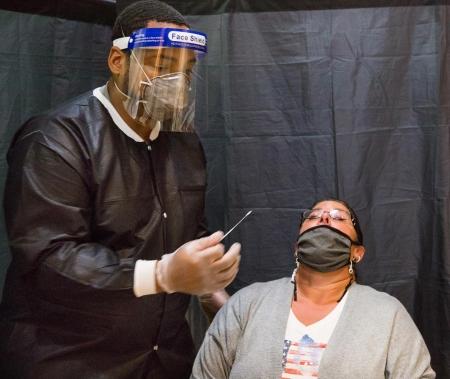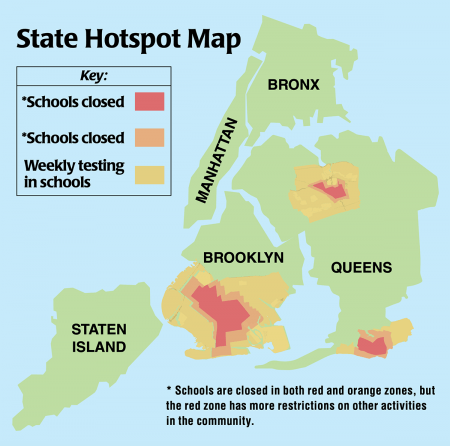Schools closed in COVID-19 hotspot areas

Lisa Nocera, a school secretary at PS 164 in Brooklyn, is tested at the school for COVID-19 by nurse Howard Johnson of Affiliated Physicians.

The city had to start closing school buildings en masse shortly after it had successfully reopened them all after certain Brooklyn and Queens neighborhoods experienced virus outbreaks.
By Oct. 8, 169 public schools and sites in these COVID-19 hotspots had moved to fully remote.
Prodded by the union and its members, Mayor Bill de Blasio announced on Sunday, Oct. 4, that more than 100 schools in nine hotspot ZIP codes would cease in-person instruction the following Wednesday, pending state approval of his plan. The following day, Gov. Andrew Cuomo ordered the schools closed one day earlier and then released his own color-coded map he contended better reflected the actual clusters.
After hours spent reconciling the state and city maps, the city Department of Education announced on Oct. 7 that an additional 33 schools were going fully remote the following morning. All the schools in the original nine ZIP codes were to stay remote at least through Oct. 21, school officials announced.
"We have entered a new phase with the virus, where we have to fight outbreaks neighborhood by neighborhood," said UFT President Michael Mulgrew. "We have to work to keep school communities in hotspots safe, and to keep the infection rate from going up and again shuttering our entire city."
Prior to the closures, the city, in coordination with the UFT, conducted mobile testing in schools in the hotspot areas. Of 1,859 test results as of Oct. 7, only two were positive, according to DOE data, suggesting the virus had not yet made significant inroads in the public schools in those places.
Under the Sept. 1 testing agreement with the union, the city had criteria for closing an individual school with an outbreak or the entire school system, but nothing in between. The mayor conceded the city's policy needed to be amended as infection rates spiked well above 3% in certain areas and the UFT demanded the city take measures to prevent the virus from reaching public schools in those communities.
"Many people were scared to come into school and get sick," said Sara McInerny, a teacher and the chapter leader at PS 164 in Brooklyn's Borough Park, one of the coronavirus hotspots.
She said a particular concern among PS 164 staff was that the school's playground was shared with the community and therefore was a potential site of virus transmission.
"The UFT put together a group to help the educators to advocate for themselves," she said. "We were able to get some needed attention."
As they faced spiking coronavirus rates in their communities, some schools faced logistical challenges to keeping themselves and their students safe while they waited for the city to act.
At PS 177, in Brooklyn's Midwood hotspot, the school saw its first COVID-19 infection of the school year after the first day of in-person instruction on Sept. 29. By the end of the week, much of the staff was working from home in quarantine.
"The internet was not working properly in the building," said Antonella Lombardo, the school's theater arts teacher and the UFT chapter leader. "The staff that had been in the building felt alone, frustrated and scared."
The UFT connected PS 177 educators with their colleagues at IS 96 and helped them set up a remote work arrangement using IS 96's facilities.
"They inspected the designated classrooms to make sure that they had been cleaned properly," said Lombardo.
The union then worked with the IS 96 administration to set up tables and chairs outside in their schoolyard where the PS 177 staff conducted virtual meetings.
While acknowledging the disruption for staff, students and families, UFT President Michael Mulgrew said the decision to close schools in the hotspots was "the right decision, one that helps protect our schools, our neighborhoods and ultimately our city."
"We definitely feel relieved that action was taken," said McInerny.
The governor's color-coded map will now be the official map. Another 308 public school sites in the state's yellow zone are being targeted for careful monitoring. Mandatory weekly testing began on Oct. 23 in these schools.
Meanwhile, the city and the DOE began their random testing program in all schools on Oct. 9. In accordance with the school testing agreement reached with the UFT on Sept. 1, a blind representative sample, composed of 10% to 20% of all students and staff in every school, will be selected each month for COVID-19 testing.
The neighborhoods battling coronavirus flare-ups include Gravesend, Homecrest, Bensonhurst, Mapleton, Flatlands, Gerritsen Beach and Sheepshead Bay in Brooklyn, and Edgemere, Far Rockaway, Kew Gardens, Kew Gardens Hill, Forest Hills and Rego Park in Queens.